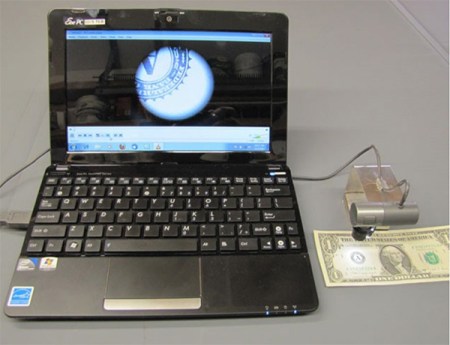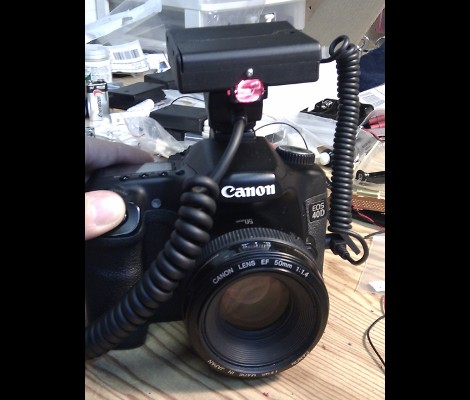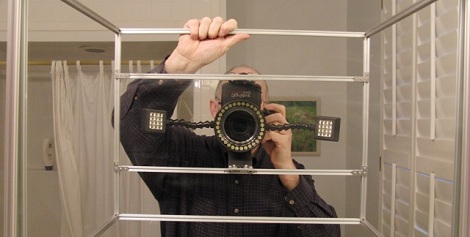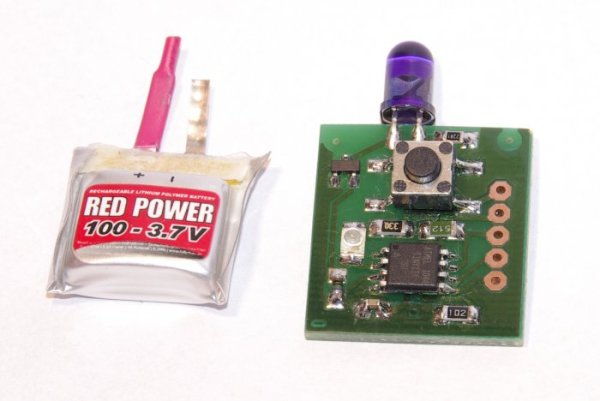Since most DSLR cameras now have an IR communication port, [Julius] thought it would be a good idea to build an IR shutter release remote. He has released the plans for two versions; a single sided hand etched one, and a double sided one to have made professionally. He notes that it should have a range of at least 10 meters thanks to the 100mAh Li-Po battery and a reasonably high power IR LED. You can download the source code as well as the etching mask and eagle files from the wiki page. He does note that you may have to change the pattern sent to match your camera.
digital cameras hacks984 Articles
Hack A Webcam And A Film Camera Into A USB Microscope

Most of you probably have a webcam sitting around somewhere, and after all the high voltage projects you’ve done using disposable cameras, we bet you have some camera lenses too. You could always do what [Butch] did and combine the lens from the camera with the webcam to do some up close inspection.
This seems like something we’ve seen several times, but we can’t find it in our archive. Such a simple and quick hack looks surprisingly effective in his shots. If you want to see the details, like where he tied into the webcam’s board to power an external LED, you’ll have to download the PDF.
Building A Digital Camera From Scratch

Sure, [Stan] could have bought a nice full-frame DSLR like a Canon 5D or a Nikon D3, but where’s the fun in that when he could build his own digital camera? The build isn’t done yet, but [Stan] did manage to take a few sample pics.
The 14 Megapixel sensor [Stan] found was originally used for benchtop applications. There isn’t any reason it can’t be used for photography, so all that needed to be done was design a camera around this sensor.
[Stan] built his hardware around a DSP, an FPGA and a pair of ADCs, an amazing piece of engineering. Of course building a full-frame digital camera has as much to do with mechanics as electronics, so [Stan] used a 60mm cage system and a 3d-printed nylon enclosure.
Of course, [Stan]’s camera doesn’t look much like and off-the-shelf DSLR. There’s a reason for this; the sensor in the camera has a rolling shutter, much like the last few iPhones instead of a focal plane shutter. Not a bad piece of work, we only wish there were more build pics.
Seeing With Another Person’s Eyes

We suppose they could just trade shoes, but that wouldn’t be a hack. [Timothy] wanted to design a team-building exercise at work, and he figured the best way to get some empathy would be to have people swap eyes. He calls his project eyeSwap and it is supposed to, “put the eye back in team.”
[Tim] found a few CRT viewfinders in a junk box attached small video cameras to each one. During the ‘training phase’ of his team-building exercises, both people playing the game complete a few hand-eye coordination tasks to get a feel for the rig. After the training phase, the inputs are swapped; Alice’s cameras are sent to Bob’s viewfinders and vice versa. The participants then complete the same tasks they did during the training phase.
The tasks aren’t that hard – putting balls into holes, for example – but it does require a huge amount of communication and coordination. eyeSwap reportedly builds trust and empathy towards others, and looks like a lot more fun than a ‘trust fall.’
Check out the video of two people playing eyeSwap after the break.
Auto-Focus Assist Hack Keeps Improving

[Adrian Onsen] keeps making improvements on his auto-focus assist hack for DSLR cameras. The module seen above is version 3.0, which makes a few changes to the previous hardware and also presents a much more finished look.
With version 2 [Adrian] was using a defocused laser to illuminate dark subjects so the DSLR auto-focus could be used. It worked, but wasn’t really ideal. This time around he’s swapped out the laser diode for an autofocus assist lamp salvaged from a Canon 550EX he picked up ‘as is’ on eBay. It is mounted on the front of his project enclosure, using two alkaline batteries for power. It sounds like [Adrian] is struggling a bit with his circuit design. He want’s to make it work with either alkaline or rechargeable AA batteries (just two, down the from four AAAs used in version 2) but so far the rechargeable are a no-go. They power the circuit, but must not put out enough light for the sensor to work.
Future plans include getting rid of the external cords by adding a hot shoe connector.
The Picture Post – Observe Your World In Extreme Slow Motion
The “Picture Post”, a tool for a program going on through the University of New Hampshire, is a method of taking what amounts to extreme time-lapse photography. The purpose of this project is to observe the world around you with a 360 degree view taken at a regular interval.
The setup is quite simple consisting of a 9 inch diameter post, and an octagon to set your camera against. Just place your camera one edge, take the picture and repeat around the octagon until done. You can register on their site to make your post official and contribute to society’s general knowledge about the environment and seasonal changes.
Although interesting in itself, this concept could be applied to many situations that one would want to record in this manner. For instance, a “hacker post” could be set up in a hackerspace for members to record their projects on or even the progress of the building itself. For another much less developed way to take photos, check out this trigger device using air freshener parts!
via [Make Magazine]
Zero-G Experiments Will Make Some Pretty Pictures

Does a yo-yo work in zero-g? How about a paper airplane? These questions were answered in 1985 on the Space Shuttle Discovery, but reproduction of results is the cornerstone of the scientific method. [Rob] is about to reproduce some of the awesome zero-g pictures by riding on a vomit comet and taking a few pictures of water globes colliding.
For the last few months, [Rob] has had a standby ticket on the G-Force One, a plane that takes passengers on parabolic arcs to simulate microgravity. He was lucky as his standby ticket allowed him to take a few experiments on board, so [Rob] decided there’s just not enough awesome pictures of water colliding in zero-g.
He built a rig out of micro t-slot aluminum. A DSLR is mounted to the frame along with a few ‘test tubes’ containing water. When [Rob] blows through a tube, a small sphere of water will be released to collide with other object. Think of it as the nerd’s version of water splash photography.
Of course, a trip through zero-g wouldn’t be complete without a few more experiments. [Rob] plans on testing a few toys to see if yo-yos ‘sleep’ without gravity (they don’t), and if a grandfather clock works on the moon (there’s a month-long day, so kind of). We can’t wait to see [Rob]’s pictures once he comes back to Earth.












